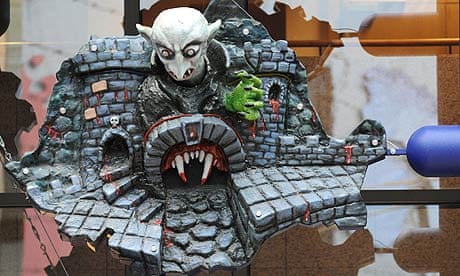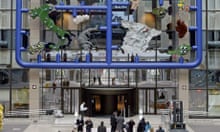Well, I laughed. But then I'm not from Bulgaria, have never been a subjugated citizen of the Ottoman Empire and am not overly sensitive to it being described as a Turkish toilet. Romania as a Dracula theme park, Spain as a building site, globally warmed Holland as a sea dotted with minarets, Italy as a north-south football match – these may be cheap jibes, but they have enough of a grip on the collective psyche to resist dismissal out of hand.
David Cerny's elaborate, well-conceived artwork celebrating the Czech Republic's presidency of the European Union seems purpose-made for the English (and I use that word advisedly) sense of humour. A lavish combination of toilet jokes, jaded national stereotypes, mild offensiveness, post-colonial chippiness and jingoism presented in the form of an outdated schoolboy hobby, Entropa ticks all the boxes we could want. A large-scale Airfix kit of Euro-parts, it provides us with everything we need to assemble, if not the Europe we may wish for, at least the one we're presently saddled with. Best of all is "British artist" Khalid Asadi's contribution to this assemblage: an entirely absent UK. What finer way to represent nearly four decades of whingeing, carping, fence-sitting and back-turning by our consistently insular political classes than to acknowledge the nation's stubborn pretence that we're not part of Europe at all?
Of course, Asadi does not exist. Like all the other artists involved, whose statements and biographies appear in the accompanying brochure, he is one of Cerny's inventions. The online English edition of Bulgaria's newspaper, Standart, charts the lengths they have gone to in trying to track down their own fictitious representative, Elena Djelebova. She is said to have exhibited at a prestigious Sofia gallery, but unsurprisingly is not known there. Asadi's biography, by contrast, is a triumph of provincial anonymity. A succession of shows in Lancashire and Yorkshire venues such as Gallery over the Shop in Southport is leavened only by the suggestive loutishness of The Beer Mat Show in Alicante. The whole construction rubs up beautifully against this country's London-centred cultural presumptions. None of this, perhaps, adds up to a radically new interpretation of British cultural life; but it is almost reassuring to have the discomfort one feels about its disparities gently mocked from outside.
In the end, one presumes Entropa will be dismantled because the EU requires unanimity on all things. Too many people will decide that they are not quite able to shrug off its irreverence. It will be said that its humour is childish, inappropriate, harsh, or ignorant. What this is likely to mean, though, is that Cerny's project is unacceptable because it is art. You can commission a sculpture or a painting or a mural to mark an occasion or represent some belief or other, but you can't commission a work of art, because art cannot be anything other than ambivalent.
Or maybe you can. It seems to me that the work is really the elaborate instigation of this mild political scandal, together with the confected froth of media comment to which these words are a minuscule addition.


